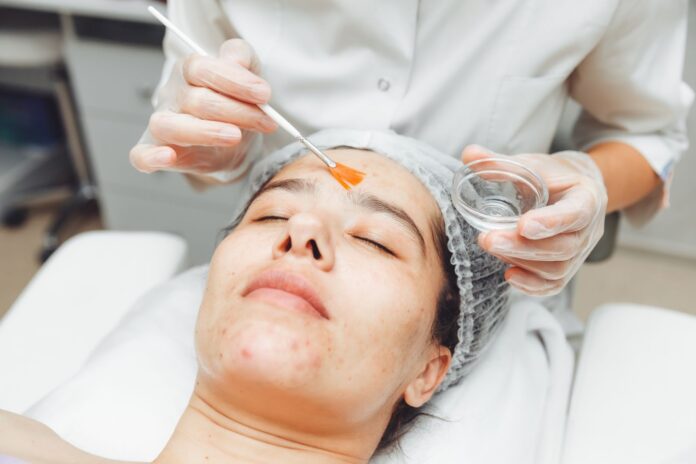Dark spots on the face, often referred to as hyperpigmentation, are a common skin concern affecting people of all ages and skin types. They may appear due to various reasons such as sun damage, acne scars, hormonal fluctuations, aging, or inflammation. These spots can vary in color, from light brown to deep black, and their severity often determines the choice of treatment.
This brings us to a common question: Are peels effective in treating dark spots, especially when seeking solutions like Chemical Peels in Dubai? People seeking a brighter, clearer complexion often explore skin treatments that can target uneven skin tone. One of the most talked-about options for this purpose is chemical peels.
What Are Chemical Peels?
Chemical peels are skin-resurfacing treatments that use chemical solutions to exfoliate the top layers of the skin. These treatments stimulate cell turnover, allowing the skin to heal and regenerate with a more even tone and texture. The intensity of a peel can range from superficial to deep, depending on the strength of the chemical solution used and the skin concern being addressed.Superficial peels gently exfoliate the outermost layer, while medium and deep peels target deeper layers for more pronounced results. These treatments are performed under professional supervision and are commonly recommended for pigmentation issues, acne, sun damage, and aging signs.
How Do Peels Help with Dark Spots?
Chemical peels work by sloughing off the layer of dead skin cells that contain concentrated melanin—the pigment responsible for dark spots. As new skin emerges, the pigmentation appears lighter, and with regular sessions, spots can fade significantly or even disappear. The effectiveness depends on the depth of the peel and the type of pigment. Lighter peels may require multiple sessions, while deeper peels offer more dramatic improvement in fewer treatments. Importantly, peels also stimulate collagen production, helping the skin appear healthier and more radiant overall.
Types of Chemical Peels for Dark Spots
Superficial Peels
These include alpha-hydroxy acids (AHAs) like glycolic acid and lactic acid. They are ideal for treating minor discoloration and improving skin brightness.
Medium Peels
Using agents like trichloroacetic acid (TCA), these peels target moderate pigmentation and deeper skin layers for a more significant effect.
Deep Peels
Phenol-based peels fall into this category and are reserved for intense pigmentation issues. They require longer recovery time but deliver powerful results.
Comparison of Peel Types for Dark Spots
| Peel Type | Ingredients | Target Depth | Ideal For | Recovery Time |
|---|---|---|---|---|
| Superficial | Glycolic, Lactic | Epidermis | Mild spots, uneven texture | 1–3 days |
| Medium | TCA | Dermis | Moderate pigmentation | 5–7 days |
| Deep | Phenol | Deeper Dermis | Severe dark spots, scars | 10–14+ days |
Are Chemical Peels Safe for All Skin Types?
Yes, but with caution. While chemical peels can be effective for various skin tones, individuals with darker skin must opt for milder peels to avoid post-inflammatory hyperpigmentation (PIH). Customized treatment plans based on skin type, sensitivity, and pigmentation depth can ensure better outcomes and reduce risks.
Key Benefits of Using Peels for Dark Spots
Skin Brightening
Peels help eliminate dull skin layers, resulting in a more luminous complexion.
Even Skin Tone
By reducing melanin deposits, peels smooth out uneven pigmentation and dark patches.
Improved Texture
As peels stimulate collagen and cell turnover, skin feels smoother and firmer.
Acne Scar Reduction
Certain peels also help fade acne-related dark spots and shallow scars.
FAQs
1. How soon will I see results from a chemical peel?
You may notice a brighter complexion within a week of a superficial peel. However, reducing dark spots often requires several sessions over a few months.
2. Can peels make dark spots worse?
When performed incorrectly or without proper aftercare, peels may cause irritation or post-inflammatory pigmentation, especially in darker skin types. It’s important to follow professional guidance.
3. Do chemical peels hurt?
Most patients experience tingling or mild burning during the procedure, especially with stronger peels. Discomfort is usually brief and manageable.
4. Is there downtime after a chemical peel?
Yes, depending on the peel strength. Superficial peels may cause mild redness or flaking, while deeper peels require more recovery time.
5. Can I combine peels with other treatments?
Yes. Chemical peels can be paired with other therapies like microdermabrasion, microneedling, or laser treatments for enhanced results. However, the timing and order of treatments should be professionally determined.
Conclusion
Chemical peels are a scientifically backed, effective solution for dark spots and overall skin rejuvenation. They work by targeting melanin buildup and promoting fresh skin turnover, which can significantly fade unwanted pigmentation. Whether you’re dealing with acne marks, sun spots, or uneven skin tone, chemical peels—when chosen and applied correctly—offer a transformative path to clearer skin.
































